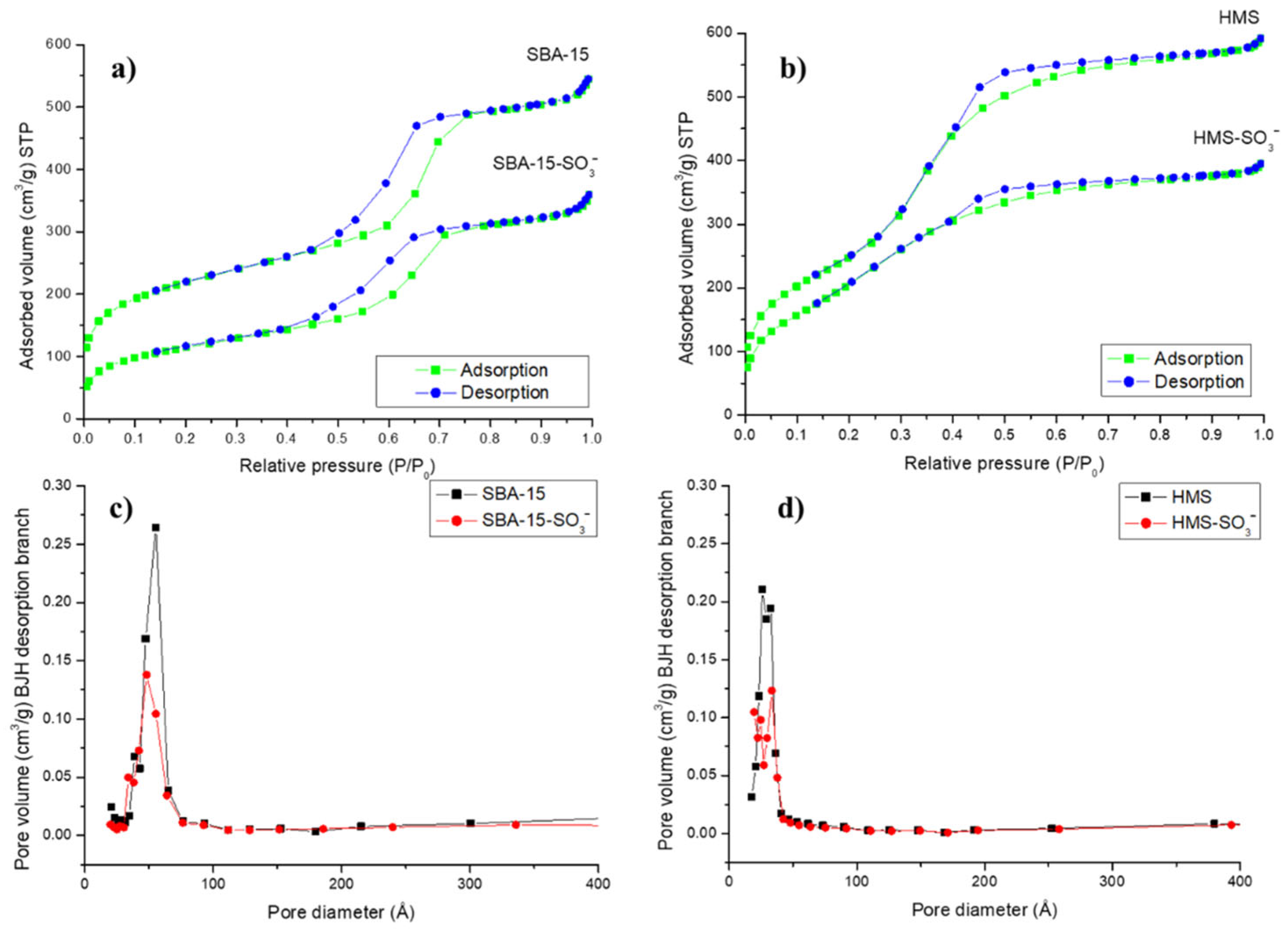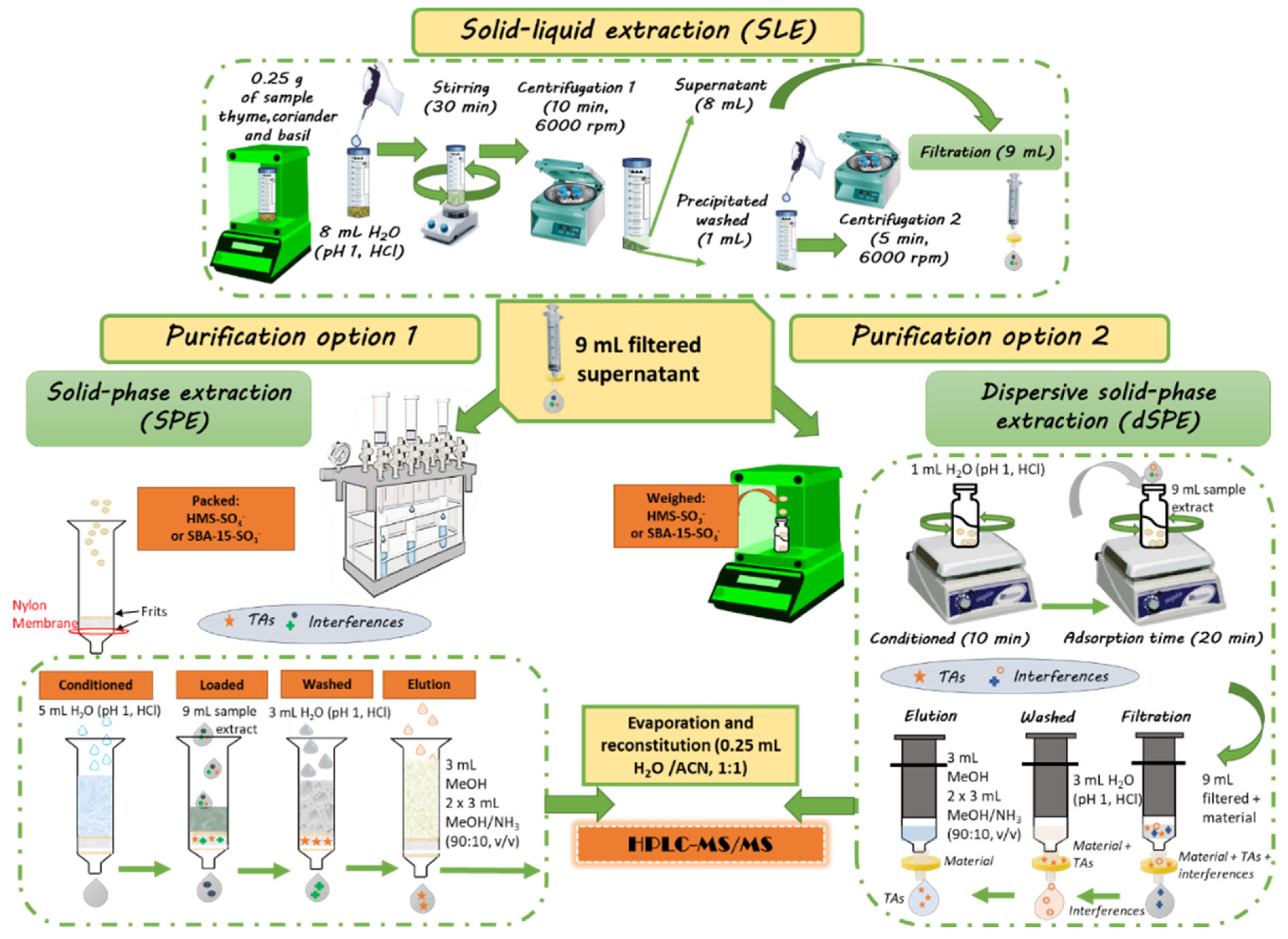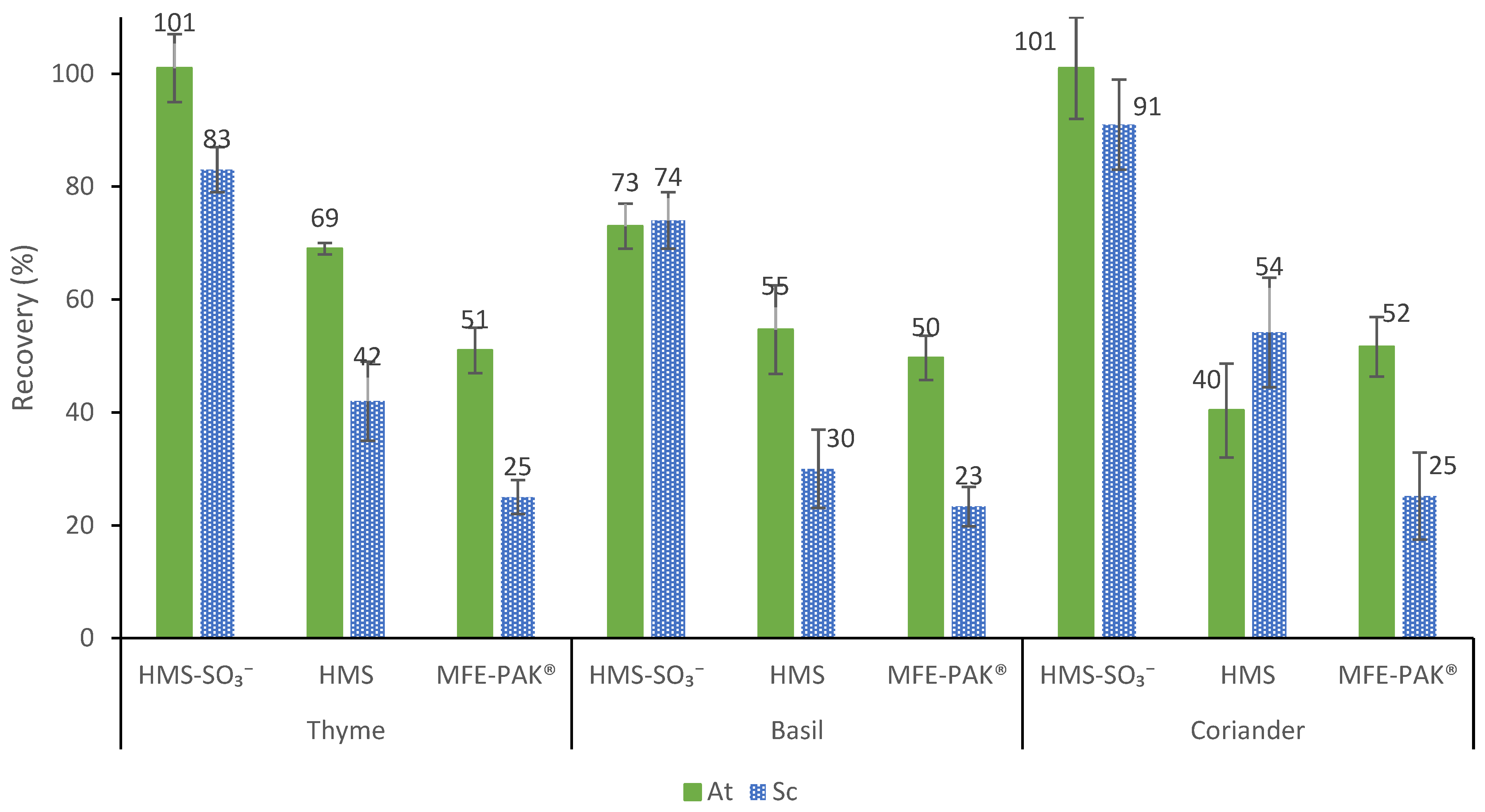Mesostructured Silicas as Cation-Exchange Sorbents in Packed or Dispersive Solid Phase Extraction for the Determination of Tropane Alkaloids in Culinary Aromatics Herbs by HPLC-MS/MS
Abstract
:1. Introduction
2. Results and Discussion
2.1. Characterization of Mesostructured Silicas
2.2. Selection of the Best Conditions for Sample Treatment Procedure
2.3. Method Validation
2.4. Analysis of Samples
3. Conclusions
4. Materials and Methods
4.1. Reagents and Materials
4.2. Samples
4.3. Synthesis of Sulfonic Acid-Functionalized Mesostructured Silicas
4.4. Characterization of Mesostructured Silicas Materials
4.5. Chromatographic Analysis of TAs
4.6. Selection of the Best Conditions for Sample Treatment Procedure
4.7. Sample Treatment Procedure
4.8. Method Validation
Supplementary Materials
Author Contributions
Funding
Institutional Review Board Statement
Informed Consent Statement
Conflicts of Interest
References
- Inoue, M.; Lyle, E.C. Medicinal and Aromatic Plants—Uses and Functions. In Horticulture: Plants for People and Places; Dixon, G., Aldous, D., Eds.; Springer: Dordrecht, The Netherlands, 2014; Volume 2, pp. 645–669. ISBN 9789401785815. [Google Scholar]
- Giannenas, I.; Sidiropoulou, E.; Bonos, E.; Christaki, E.; Florou-Paneri, P. The history of herbs, medicinal and aromatic plants, and their extracts: Past, current situation and future perspectives. In Feed Additives: Aromatic Plants and Herbs in Animal Nutrition and Health; Florou-Paneri, P., Christaki, E., Giannenas, I., Eds.; Elsevier Inc.: Amsterdam, The Netherlands, 2019; pp. 1–18. ISBN 9780128147016. [Google Scholar]
- El-Sayed, S.M.; Youssef, A.M. Potential application of herbs and spices and their effects in functional dairy products. Heliyon 2019, 5, e01989. [Google Scholar] [CrossRef] [PubMed] [Green Version]
- Peter, K.V.; Shylaja, M.R. Introduction to herbs and spices: Definitions, trade and applications. In Woodhead Publishing Series in Food Science, Technology and Nutrition, Handbook of Herbs and Spices; Peter, K.V., Ed.; Woodhead Publishing Limited: Philadelphia, PA, USA, 2012; Volume 1, pp. 1–24. ISBN 9780857095671. [Google Scholar]
- Nour, V.; Trandafir, I.; Cosmulescu, S. Bioactive compounds, antioxidant activity and nutritional quality of different culinary aromatic herbs. Not. Bot. Horti Agrobot. Cluj-Napoca 2017, 45, 179–184. [Google Scholar] [CrossRef] [Green Version]
- Pereira, C.; Barros, L.; Ferreira, I.C.F.R. A Comparison of the Nutritional Contribution of Thirty-nine Aromatic Plants used as Condiments and/or Herbal Infusions. Plant Foods Hum. Nutr. 2015, 70, 176–183. [Google Scholar] [CrossRef] [PubMed]
- Arcella, D.; Altieri, A.; Horváth, Z. Human acute exposure assessment to tropane alkaloids. EFSA J. 2018, 16, 5160. [Google Scholar] [CrossRef] [Green Version]
- Izcara, S.; Casado, N.; Morante-Zarcero, S.; Sierra, I. A miniaturized QuEChERS method combined with ultrahigh liquid chromatography coupled to tandem mass spectrometry for the analysis of pyrrolizidine alkaloids in oregano samples. Foods 2020, 9, 1319. [Google Scholar] [CrossRef] [PubMed]
- Rivera-Pérez, A.; Romero-González, R.; Frenich, A.G. Determination and Occurrence of Alkenylbenzenes, Pyrrolizidine and Tropane Alkaloids in Spices, Herbs, Teas, and Other Plant-derived Food Products Using Chromatographic Methods: Review from 2010–2020. Food Rev. Int. 2021, 38, 1–27. [Google Scholar] [CrossRef]
- European Food Safety Authority. Scientific Opinion on Tropane alkaloids in food and feed. EFSA J. 2013, 11, 3386. [Google Scholar] [CrossRef]
- Mulder, P.P.J.; de Nijs, M.; Castellari, M.; Hortos, M.; MacDonald, S.; Crews, C.; Hajslova, J.; Stranska, M. Occurrence of tropane alkaloids in food. EFSA Support. Publ. 2016, 13, 1140E. [Google Scholar] [CrossRef] [Green Version]
- González-Gómez, L.; Morante-Zarcero, S.; Pérez-Quintanilla, D.; Sierra, I. Occurrence and Chemistry of Tropane Alkaloids in Foods, with a Focus on Sample Analysis Methods: A Review on Recent Trends and Technological Advances. Foods 2022, 11, 407. [Google Scholar] [CrossRef] [PubMed]
- Abia, W.A.; Montgomery, H.; Nugent, A.P.; Elliott, C.T. Tropane alkaloid contamination of agricultural commodities and food products in relation to consumer health: Learnings from the 2019 Uganda food aid outbreak. Compr. Rev. Food Sci. Food Saf. 2021, 20, 501–525. [Google Scholar] [CrossRef] [PubMed]
- European Union. Commision Recommendation (EU) 2015/976 of 19 June 2015 on the monitoring of the presence of tropane alkaloids in food. Off. J. Eur. Union 2015, 11, 97–98. [Google Scholar] [CrossRef]
- European Union. Commission regulation (EU) 2021/1408 of 27 August 2021 amending Regulation (EC) No 1881/2006 as regards maximum levels of tropane alkaloids in certain foodstuffs. Off. J. Eur. Union 2021, 304, 1–4. [Google Scholar]
- Cirlini, M.; Demuth, T.M.; Biancardi, A.; Rychlik, M.; Dall’Asta, C.; Bruni, R. Are tropane alkaloids present in organic foods? Detection of scopolamine and atropine in organic buckwheat (Fagopyron esculentum L.) products by UHPLC–MS/MS. Food Chem. 2018, 239, 141–147. [Google Scholar] [CrossRef]
- Mulder, P.P.J.; Pereboom-de Fauw, D.P.K.H.; Hoogenboom, R.L.A.P.; de Stoppelaar, J.; de Nijs, M. Tropane and ergot alkaloids in grain-based products for infants and young children in the Netherlands in 2011–2014. Food Addit. Contam. Part B Surveill. 2015, 8, 284–290. [Google Scholar] [CrossRef]
- Marín-Sáez, J.; Romero-González, R.; Garrido Frenich, A. Degradation of tropane alkaloids in baked bread samples contaminated with Solanaceae seeds. Food Res. Int. 2019, 122, 585–592. [Google Scholar] [CrossRef]
- Urban, M.; Hann, S.; Rost, H. Simultaneous determination of pesticides, mycotoxins, tropane alkaloids, growth regulators, and pyrrolizidine alkaloids in oats and whole wheat grains after online clean-up via two-dimensional liquid chromatography tandem mass spectrometry. J. Environ. Sci. Health Part B Pestic. Food Contam. Agric. Wastes 2019, 54, 98–111. [Google Scholar] [CrossRef]
- Shimshoni, J.A.; Duebecke, A.; Mulder, P.P.J.; Cuneah, O.; Barel, S. Pyrrolizidine and tropane alkaloids in teas and the herbal teas peppermint, rooibos and chamomile in the Israeli market. Food Addit. Contam. Part A Chem. Anal. Control Expo. Risk Assess. 2015, 32, 2058–2067. [Google Scholar] [CrossRef]
- Cirlini, M.; Cappucci, V.; Galaverna, G.; Dall’Asta, C.; Bruni, R. A sensitive UHPLC-ESI-MS/MS method for the determination of tropane alkaloids in herbal teas and extracts. Food Control 2019, 105, 285–291. [Google Scholar] [CrossRef]
- Dzuman, Z.; Jonatova, P.; Stranska-Zachariasova, M.; Prusova, N.; Brabenec, O.; Novakova, A.; Fenclova, M.; Hajslova, J. Development of a new LC-MS method for accurate and sensitive determination of 33 pyrrolizidine and 21 tropane alkaloids in plant-based food matrices. Anal. Bioanal. Chem. 2020, 412, 7155–7167. [Google Scholar] [CrossRef]
- Marín-Sáez, J.; Romero-González, R.; Garrido Frenich, A. Multi-analysis determination of tropane alkaloids in cereals and solanaceaes seeds by liquid chromatography coupled to single stage Exactive-Orbitrap. J. Chromatogr. A 2017, 1518, 46–58. [Google Scholar] [CrossRef]
- Romera-Torres, A.; Romero-González, R.; Martínez Vidal, J.L.; Garrido Frenich, A. Simultaneous analysis of tropane alkaloids in teas and herbal teas by liquid chromatography coupled to high-resolution mass spectrometry (Orbitrap). J. Sep. Sci. 2018, 41, 1938–1946. [Google Scholar] [CrossRef] [PubMed]
- Marín-Sáez, J.; Romero-González, R.; Garrido Frenich, A. Reliable determination of tropane alkaloids in cereal based baby foods coupling on-line spe to mass spectrometry avoiding chromatographic step. Food Chem. 2019, 275, 746–753. [Google Scholar] [CrossRef] [PubMed]
- Marín-Sáez, J.; Romero-González, R.; Garrido Frenich, A. Effect of tea making and boiling processes on the degradation of tropane alkaloids in tea and pasta samples contaminated with Solanaceae seeds and coca leaf. Food Chem. 2019, 287, 265–272. [Google Scholar] [CrossRef] [PubMed]
- Casado, N.; Pérez-Quintanilla, D.; Morante-Zarcero, S.; Sierra, I. Current development and applications of ordered mesoporous silicas and other sol–gel silica-based materials in food sample preparation for xenobiotics analysis. TrAC Trends Anal. Chem. 2017, 88, 167–184. [Google Scholar] [CrossRef]
- Sierra, I.; Morante-Zarcero, S. New Advances in Food Sample Preparation with Nanomaterials for Organic Contaminants Analysis by Liquid Chromatography; Elsevier Inc.: Amsterdam, The Netherlands, 2018; ISBN 9780128127926. [Google Scholar]
- González-Gómez, L.; Morante-Zarcero, S.; Pérez-Quintanilla, D.; Sierra, I. Simultaneous determination of furanic compounds and acrylamide in insect-based foods by hplc-qqq-ms/ms employing a functionalized mesostructured silica as sorbent in solid-phase extraction. Foods 2021, 10, 1557. [Google Scholar] [CrossRef] [PubMed]
- Gañán, J.; Morante-Zarcero, S.; Pérez-Quintanilla, D.; Marina, M.L.; Sierra, I. One-pot synthesized functionalized mesoporous silica as a reversed-phase sorbent for solid-phase extraction of endocrine disrupting compounds in milks. J. Chromatogr. A 2016, 1428, 228–235. [Google Scholar] [CrossRef] [PubMed]
- Gañán, J.; Morante-Zarcero, S.; Pérez-Quintanilla, D.; Sierra, I. 2-Mercaptopyrimidine-functionalized mesostructured silicas to develop electrochemical sensors for a rapid control of scopolamine in tea and herbal tea infusions. Microchem. J. 2020, 157, 104877. [Google Scholar] [CrossRef]
- Casado, N.; Pérez-Quintanilla, D.; Morante-Zarcero, S.; Sierra, I. Evaluation of bi-functionalized mesoporous silicas as reversed phase/cation-exchange mixed-mode sorbents for multi-residue solid phase extraction of veterinary drug residues in meat samples. Talanta 2017, 165, 223–230. [Google Scholar] [CrossRef] [PubMed]
- Loussala, H.M.; Feng, J.; Han, S.; Sun, M.; Ji, X.; Li, C.; Fan, J.; Pei, M. Carbon nanotubes functionalized mesoporous silica for in-tube solid-phase microextraction of polycyclic aromatic hydrocarbons. J. Sep. Sci. 2020, 43, 3275–3284. [Google Scholar] [CrossRef] [PubMed]
- Loussala, H.M.; Han, S.; Feng, J.; Sun, M.; Feng, J.; Fan, J.; Pei, M. Mesoporous silica hybridized by ordered mesoporous carbon for in-tube solid-phase microextraction. J. Sep. Sci. 2020, 43, 3655–3664. [Google Scholar] [CrossRef] [PubMed]
- Sun, M.; Han, S.; Maloko Loussala, H.; Feng, J.; Li, C.; Ji, X.; Feng, J.; Sun, H. Graphene oxide-functionalized mesoporous silica for online in-tube solid-phase microextraction of polycyclic aromatic hydrocarbons from honey and detection by high performance liquid chromatography-diode array detector. Microchem. J. 2021, 166, 106263. [Google Scholar] [CrossRef]
- González-Gómez, L.; Gañán, J.; Morante-Zarcero, S.; Pérez-Quintanilla, D.; Sierra, I. Sulfonic Acid-Functionalized SBA-15 as Strong Cation-Exchange Sorbent for Solid-Phase Extraction of Atropine and Scopolamine in Gluten-Free Grains and Flours. Foods 2020, 9, 1854. [Google Scholar] [CrossRef]
- Casado, N.; Gañán, J.; Morante-Zarcero, S.; Sierra, I. New advanced materials and sorbent-based microextraction techniques as strategies in sample preparation to improve the determination of natural toxins in food samples. Molecules 2020, 25, 702. [Google Scholar] [CrossRef] [Green Version]
- Casado, N.; Morante-Zarcero, S.; Pérez-Quintanilla, D.; Sierra, I. Evaluation of mesostructured silicas with wormhole-like framework functionalized with hydrophobic groups as alternative sorbents for extraction of drug residues from food samples. Mater. Lett. 2018, 220, 165–168. [Google Scholar] [CrossRef]
- Tanev, P.; Pinnavaia, T. A neutral templating route to mesoporous molecular sieves. Science 1995, 267, 865–967. [Google Scholar] [CrossRef]
- European Commission SANTE/12682/2019. Guidance Document on Analytical Quality Control and Method Validation Procedures for Pesticide Residues and Analysis in Food and Feed. Available online: https://www.eurl-pesticides.eu/userfiles/file/EurlALL/AqcGuidance_SANTE_2019_12682.pdf (accessed on 22 September 2021).
- RASFF Portal—Food and Feed Safety Alerts. Available online: https://webgate.ec.europa.eu/rasff-window/portal/? (accessed on 28 October 2020).
- European Union. Commission Regulation (EC) No 401/2006 of 23 February 2006 laying down the methods of sampling and analysis for the official control of the levels of mycotoxins in foodstuffs. Off. J. Eur. Union 2006, L70, 12–34. [Google Scholar]
- Zhao, D.; Huo, Q.; Feng, J.; Chmelka, B.F.; Stucky, G.D. Nonionic triblock and star diblock copolymer and oligomeric sufactant syntheses of highly ordered, hydrothermally stable, mesoporous silica structures. J. Am. Chem. Soc. 1998, 120, 6024–6036. [Google Scholar] [CrossRef]
- AOAC International AOAC Official Methods of Analysis—Appendix K: Guidelines for Dietary Supplements and Botanicals. AOAC Off. Methods Anal. 2013, 2, 32.
- Thompson, M.; Ellison, S.L.R.; Wood, R. Harmonized guidelines for single-laboratory validation of methods of analysis (IUPAC Technical Report). Pure Appl. Chem. 2002, 74, 835–855. [Google Scholar] [CrossRef]





| Silica | Channel Structure | Particle Morphology | L0 a (mmol SO3−/g) | SBET b (m2/g) | BJH Pore Diameter c (Å) | Pore Volume d (cm3/g) |
|---|---|---|---|---|---|---|
| SBA-15 | 1D hexagonal parallel channels | Rope-like | - | 780.0 | 56.0 | 0.80 |
| SBA-15-SO3− | 1D hexagonal parallel channels | Rope-like | 1.026 | 567.8 | 49.0 | 0.65 |
| HMS | 3D wormhole-like | Pseudo-spherical | - | 910.5 | 32.5 | 0.89 |
| HMS-SO3− | 3D wormhole-like | Pseudo-spherical | 1.105 | 707.1 | 30.3 | 0.52 |
| Standard Solution (µg/mL) | Sorbent Amount (mg) | SBA-15-SO3− | HMS-SO3− | ||||||
|---|---|---|---|---|---|---|---|---|---|
| dSPE a | SPE b | dSPE a | SPE b | ||||||
| At c | Sc d | At c | Sc d | At c | Sc d | At c | Sc d | ||
| 0.01 | 150 | 77 ± 7 | 85 ± 3 | 92 ± 1 | 118 ± 1 | 102 ± 11 | 101 ± 11 | 95 ± 6 | 99 ± 7 |
| 100 | 72 ± 1 | 70 ± 2 | 95 ± 1 | 116 ± 2 | 79 ± 4 | 74 ± 8 | 80 ± 3 | 99 ± 8 | |
| 0.001 | 100 | 85 ± 2 | 70 ± 2 | 97 ± 1 | 91 ± 2 | 83 ± 9 | 82 ± 8 | 93 ± 2 | 104 ± 5 |
| Sample (g) | Sorbent (mg) | SBA-15-SO3− | HMS-SO3− | ||||||
|---|---|---|---|---|---|---|---|---|---|
| dSPE a | SPE b | dSPE a | SPE b | ||||||
| At c | Sc d | At c | Sc d | At c | Sc d | At c | Sc d | ||
| 0.5 | 150 | 54 ± 2 | 37 ± 9 | 77 ± 3 | 61 ± 1 | 56 ± 2 | 49 ± 2 | 78 ± 2 | 74 ± 3 |
| 0.25 | 150 | 87 ± 8 | 73 ± 8 | 90 ± 3 | 88 ± 6 | 88 ± 8 | 79 ± 5 | 100 ± 3 | 98 ± 3 |
| 0.25 | 100 | 58 ± 0 | 43 ± 2 | 67 ± 3 | 48 ± 8 | 58 ± 10 | 47 ± 2 | 94 ± 3 | 82 ± 1 |
| 0.25 | 75 | - | - | - | - | - | - | 101 ± 6 | 83 ± 4 |
| 0.25 | 50 | - | - | - | - | - | - | 79 ± 7 | 64 ± 13 |
| Atropine | Scopolamine | ||||||||||
|---|---|---|---|---|---|---|---|---|---|---|---|
| Sample | Linearity (µg/mL) | Matrix Matched Calibration | R2 | MDL a (µg/kg) | MQL b (µg/kg) | ME c (%) | Matrix Matched Calibration | R2 | MDL a (µg/kg) | MQL b (µg/kg) | ME c (%) |
| Thy | 0.005–0.2 | 5.8 × 108 x + 9.9 × 105 | 0.999 | 0.8 | 2.6 | −36 | 2.0 × 108 x + 3.4 × 105 | 1.000 | 1.2 | 4.0 | −43 |
| Ba | 0.005–0.2 | 4.5 × 108 x + 9.5 × 105 | 0.999 | 1.6 | 5.3 | −50 | 1.4 × 108 x + 2.1 × 105 | 0.999 | 1.3 | 4.4 | −59 |
| Cor | 0.01–0.2 | 3.6 × 108 x − 1.7 × 106 | 0.999 | 2.1 | 6.8 | −61 | 1.0 × 108 x − 6.5 × 105 | 0.999 | 2.2 | 7.2 | −71 |
Publisher’s Note: MDPI stays neutral with regard to jurisdictional claims in published maps and institutional affiliations. |
© 2022 by the authors. Licensee MDPI, Basel, Switzerland. This article is an open access article distributed under the terms and conditions of the Creative Commons Attribution (CC BY) license (https://creativecommons.org/licenses/by/4.0/).
Share and Cite
González-Gómez, L.; Gañán, J.; Morante-Zarcero, S.; Pérez-Quintanilla, D.; Sierra, I. Mesostructured Silicas as Cation-Exchange Sorbents in Packed or Dispersive Solid Phase Extraction for the Determination of Tropane Alkaloids in Culinary Aromatics Herbs by HPLC-MS/MS. Toxins 2022, 14, 218. https://doi.org/10.3390/toxins14030218
González-Gómez L, Gañán J, Morante-Zarcero S, Pérez-Quintanilla D, Sierra I. Mesostructured Silicas as Cation-Exchange Sorbents in Packed or Dispersive Solid Phase Extraction for the Determination of Tropane Alkaloids in Culinary Aromatics Herbs by HPLC-MS/MS. Toxins. 2022; 14(3):218. https://doi.org/10.3390/toxins14030218
Chicago/Turabian StyleGonzález-Gómez, Lorena, Judith Gañán, Sonia Morante-Zarcero, Damián Pérez-Quintanilla, and Isabel Sierra. 2022. "Mesostructured Silicas as Cation-Exchange Sorbents in Packed or Dispersive Solid Phase Extraction for the Determination of Tropane Alkaloids in Culinary Aromatics Herbs by HPLC-MS/MS" Toxins 14, no. 3: 218. https://doi.org/10.3390/toxins14030218
APA StyleGonzález-Gómez, L., Gañán, J., Morante-Zarcero, S., Pérez-Quintanilla, D., & Sierra, I. (2022). Mesostructured Silicas as Cation-Exchange Sorbents in Packed or Dispersive Solid Phase Extraction for the Determination of Tropane Alkaloids in Culinary Aromatics Herbs by HPLC-MS/MS. Toxins, 14(3), 218. https://doi.org/10.3390/toxins14030218









